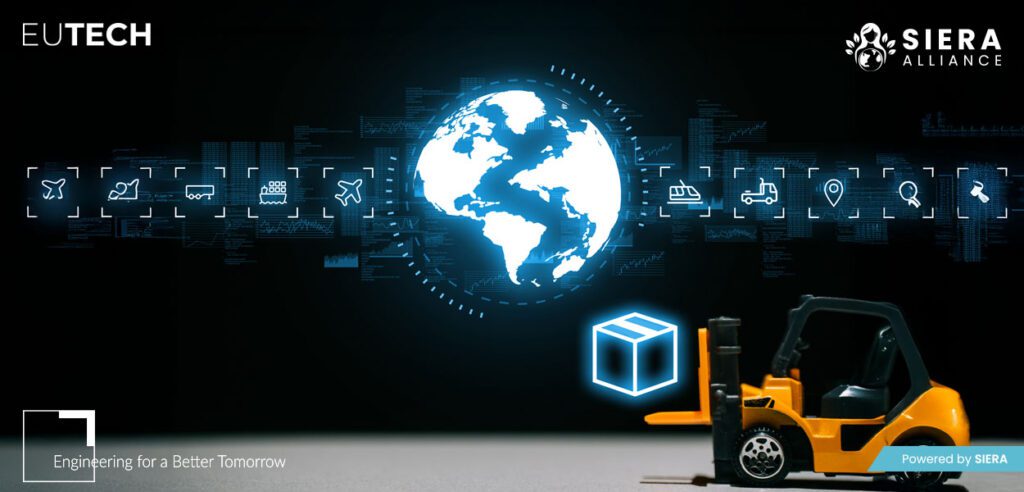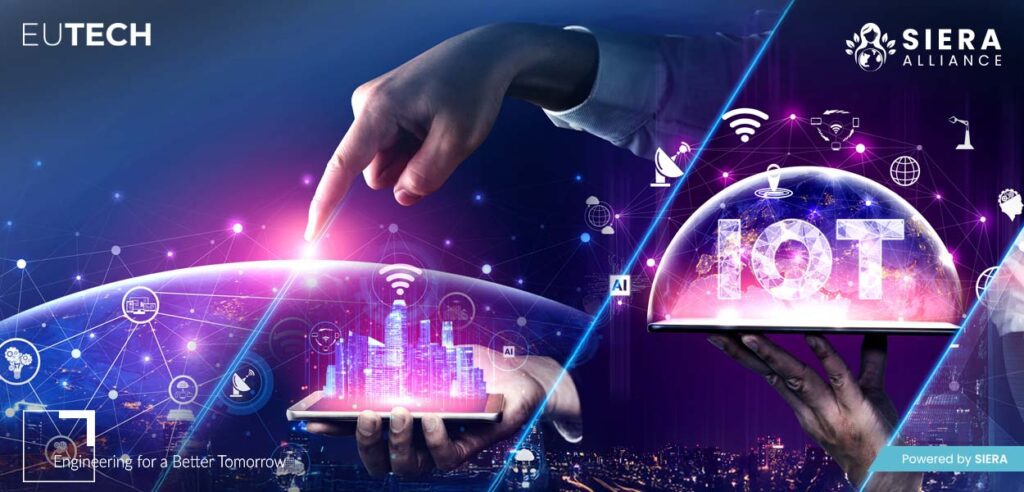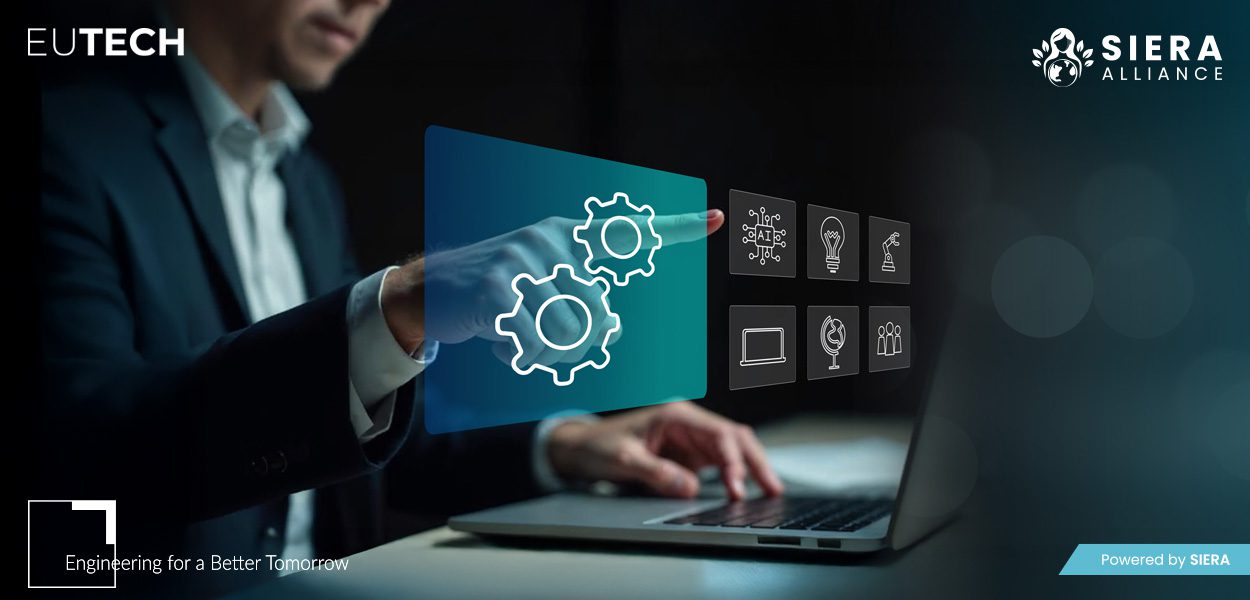Transforming Transport & Logistics with IoT and AI
The transport and logistics sector is undergoing a profound transformation as it strives to balance speed, efficiency and sustainability. By integrating sensor-laden infrastructure and intelligent analytics, companies can now optimize routes, reduce emissions, improve asset utilization and enhance customer satisfaction.
This article dives into how Internet of Things (IoT) and Artificial Intelligence (AI) are reshaping logistics, exploring key technologies, real-world case studies and actionable strategies. From predictive maintenance and autonomous fleets to supply chain transparency and green logistics, EUTECH — powered by SIERA — can help businesses unlock the full potential of these innovations.
The Power Duo: IoT Meets AI
IoT serves as the connective tissue of modern logistics networks as tiny sensors — RFID tags, telematics units, or cargo monitors — continuously gather real-time data on vehicle location, load conditions, temperature and more. AI can then be leveraged to process these vast datasets, identifying patterns, predicting disruptions and prescribing interventions.
Together, IoT and AI create a feedback loop: accurate data feeds intelligent models, in turn recommend smarter operations that are then monitored continuously. This synergy transforms logistics from resource-intensive and reactive to agile, proactive and sustainable.
Strategic Benefits of IoT and AI Integration
- Operational Efficiency and Cost Reduction
- Real-time IoT data and AI optimizations streamline routes and fleets, reducing fuel use and idle time.
- Predictive maintenance reduces downtime and costly breakdowns.
- Warehouses operate faster, with lower labor expenses.
These improvements can lead to 40% lower maintenance costs, 15% shorter travel mileage and 10-15% reductions in empty miles.
Sustainability & Emission Reductions
Logistics emissions account for a significant portion of global carbon output. AI-driven route and load optimization, along with electric/autonomous vehicles, help reduce fuel consumption and CO2 emissions. Amazon’s internal reports highlight carbon reductions from their AI logistics platforms.
Visibility and Supply Chain Resilience
IoT offers end-to-end transparency as GPS trackers, RFID and AI-powered platforms form a digital twin of the logistics network. Companies can predict disruptions or delays and reroute proactively. DHL calls this “predictive quality”, delivering smarter planning capabilities.
Customer Experience and Competitive Advantage
Accurate ETAs, real-time tracking and fewer service interruptions elevate customer satisfaction. Veho and Dispatch have reported up to 80% fewer customer calls, while Amazon sees faster and more accurate last-mile delivery thanks to AI-guided systems.
Sustainability Integration
Route efficiency and load planning can significantly reduce carbon emissions. Transitioning to electric vehicles and optimizing energy usage in warehouses further lowers environmental impact. At the same time, ports benefit from predictive planning to reduce fuel and resource intensity.

Enabling Technologies & Implementation
IoT Infrastructure: Deploy robust sensor networks — vehicle telematics, temperature monitors, RFID tags, port and warehouse instruments — across assets and locations for maximum data yield.
AI & Machine Learning Platforms: Adopt AI models for predictive maintenance, dynamic routing, anomaly detection and demand forecasting. These models learn over time, yielding better forecasts and continuous cost savings.
Digital Twins & Control Towers: Centralized dashboards bring together real-time IoT and AI insights, enabling live monitoring, scenario modeling and swift decision-making.
Autonomous Systems: Integrate with drone fleets, automated guided vehicles (AGVs) and self-driving trucks. While regulations and infrastructure evolve, pilot programs have already demonstrated impressive operational and safety gains.
Real-World Use Cases
Predictive Maintenance & Asset Management
Traditional fleets rely on scheduled servicing, but fleet telematics paired with AI can predict mechanical issues before failure. This proactive upkeep decreases unplanned downtime by up to 50% and extends vehicle lifespan by 3-5%. Logistics companies that adopt this model have reported substantial cost reductions and improved reliability.
Route Optimization & Last-Mile Efficiency
Route inefficiencies have long plagued logistics, especially during last-mile delivery. AI-enables route planning adjustments on the fly, incorporating traffic, weather, delivery windows and vehicle capacity.
For example, Uber Freight’s platform has reduced empty miles by 10-15%, saving fuel, emission and time. Similarly, Amazon’s generative-AI-powered Wellspring system analyzes satellite imagery and building data to select optimal drop-off points.
Smart Warehousing and Automation
At logistics hubs, IoT sensors and AI-driven robots are revolutionizing inventory management. Autonomous systems can transport goods, oversee stock levels and coordinate storage with minimal human intervention. Amazon’s warehouse initiatives illustrate how robotics and AI can expedite order fulfilment, reduce labor costs and minimize delays.
Autonomous & Electric Fleets
Driverless trucks and drones promise to reshape logistics. Several companies, including Aurora Innovation and Einride, are advancing Level 4 autonomous freight vehicles, which operate without human input in designated zones, reducing labor shortages and human error. Meanwhile, electric and autonomous delivery drones are also emerging for urban and rural last-mile distribution.
Smart Posts & Infrastructure
Ports are becoming high-tech hubs, integrating IoT sensors with AI-powered control systems for traffic management, resource allocation, emission monitoring and predictive planning. The Port of Busan’s AI-driven logistics “metaverse” enhanced docking efficiency by 79% and generated an annual $7.3 million in added revenue.
Challenges and Considerations
Data Quality & Interoperability: Many logistics networks use legacy systems with poor integration. Ensuring clean, standardized data across platforms is vital for AI performance.
Cybersecurity & Privacy: IoT-connected infrastructure is vulnerable to hacking. Smart ports must adopt encrypted networks and access controls to safeguard sensitive data.
Regulatory & Operational Adoption: Autonomous vehicles operate under evolving regulation. Workforce upskilling, safety protocols and business continuity plans are essential for smooth adoption.
Investment & ROI: Initial deployment of sensors, AI platforms and autonomous fleets represents major CapEx. However, EUTECH’s phased, ROI-driven strategies help ensure swift cost recovery and long-term value.
Leverage IoT & AI the EUTECH Way
EUTECH — powered by SIERA — offers end-to-end implementation of cutting-edge IoT and AI solutions across transport and logistics:
- Platform Integration & Sensors: We source and manage hardware deployments to ensure seamless data collection.
- AI Model Development: Our data scientists tailor AI for predictive maintenance, dynamic routing, demand forecasting and anomaly detection.
- Digital Twin Deployment: We build intuitive control towers that unify IoT, analytics and human oversight for real-time optimization.
- Autonomy Enablement: From pilot programs with drones or AGVs to pre-autonomous trucks, we engineer safe, compliant deployments.
- Cyber & Data Governance: We embed robust encryption, access policies and compliance frameworks to secure your logistics ecosystem.
- ROI Roadmap: EUTECH designs phased strategies that demonstrate value fast — minimizing downtime, maximizing fleet yield and improving delivery KPIs.

Looking Ahead: The Future of Smart Logistics
The logistics landscape in 2025 and beyond is reshaping around digital and sustainable principles:
- Pervasive Autonomy: Autonomous trucks, drones, AGVs and smart ports will become more commonplace as regulations catch up.
- AI Edge Integration: Deep Learning models will run alongside edge sensors — enabling ultra-fast anomaly detection and responsive controls.
- Green Logistics: AI-driven route and energy optimization, combined with alternative fuels and electric fleets, will become essential for ESG compliance.
- Ecosystem Collaboration: Public-private partnerships will underpin development of smart roads, autonomous corridors and intermodal hubs.
EUTECH — powered by SIERA — is uniquely positioned to lead clients through this transition, ensuring they remain at the forefront of innovation and efficiency in a digitally connected world.
A Smarter Path Forward with EUTECH
From customer expectations and supply-chain complexity to environmental mandates, transport and logistics businesses face increasing pressure. With EUTECH’s expertise in sensor strategy, AI analytics, digital twins, automation and sustainability integration, logistical systems can be transformed into agile, eco-friendly networks — optimized for the commerce of tomorrow.
Lead the logistics revolution, get in touch with EUTECH to start your IoT+AI journey and drive smarter, greener, future-proof operations.







